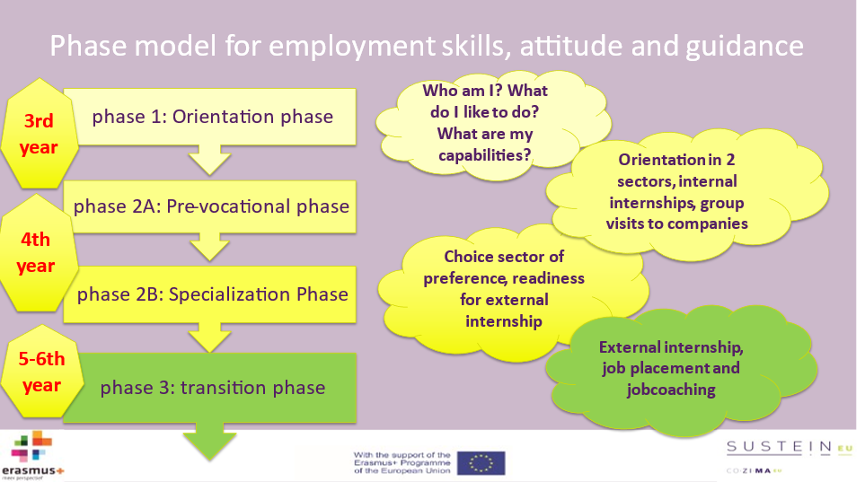
Use of Cozima portfolio for internship and career orientation
Subject:
The development of a joint Service point for internships, career orientation and guidance and how the e-Portfolio CoZiMa will be used at school and during internships in companies
Country:
Netherlands
Schools
VSO schools in Central Limburg that fall under the Aloysius Foundation and the members of the working group who were spoken to for this ursercase:
De Widdonck Weert (Nick Wijnhoven)
The Ortolan Heibloem (Naard Vaes)
The Ortolaan Roermond (Karen Backes)
Context and development
In Central Limburg there are 3 schools of the Aloysius Foundation that offer special education for young people between 12 and 18- (maximum 21) years. It concerns pupils with social and/or behavioral problems. For some of the pupils it applies that they cannot obtain a regular diploma for secondary education. After school they go directly to work. This can be wage-earning work, but for some of the pupils it will be sheltered work or daytime activities.
In order to strengthen the quality and diversity of the education on offer and to optimize cooperation with companies in the region, it has been decided that the schools will work together intensively. They have chosen to set up a joint Service point for work placements and for Career Development and Guidance (CG). The Labour Curriculum has also been aligned. The curriculum at all schools is now set up according to a Phase model. This is based on that of the Stichting Leerplanontwikkeling (SLO) (National Foundation for Curriculum Development) but has been expanded and adapted for the own specific situation.

Within this Phase Model there is an orientation phase, a vocational preparatory phase, a specialization phase and a transition phase, towards employment. The type of internship that students are offered differs per phase. From internal internships within school, external group internships to individual external internships with employers.
The strength of the Phase Model is that, in terms of internship, practical training and CG, more customization is possible for students, depending on their development. The competences and behavioral indicators are described per Phase and the schools now use the same testing and assessment framework and interview cycle. Depending on their development, progression to the next stage is possible.
In the Service point, the 3 schools work together in a working group, led by one of the directors of the three schools. This working group consists of the internship coordinators of the schools. This workgroup asks for help from other team members when necessary. We think and work from a common vision and curriculum. Assignments and methods, for example around LOB are chosen or discussed in the working group.
Companies from the region, which often receive students from different Aloysius schools on internships, now have to deal with one method, one assessment framework, forms set and maintain contact with one point of contact within the Service point.
Because all network contacts and internship companies are also housed in a common CRM system within CoZiMa, students can take advantage of all internship opportunities throughout the region. This means more choices and a better chance of finding an internship that matches the student's interests and abilities.
It also means that students who transfer from one Aloysius School to another, for example because a certain direction or sector is offered there, are not hindered by this. After all, the Curriculum is structured in the same way.
Priorities for CoZiMa in the Service Area
A great advantage of the cooperation of the schools in the Service point is that the experience and knowledge that has been gained with CoZiMa can be used. In this the schools still differ. Where one school has been working with the digital portfolio for three years, another is still at the beginning. Because the Labour Curriculum and Phase Model have now been introduced at all schools, the focus can now be on how the CoZiMa portfolio can support this curriculum per phase. This school year this has been tested in the form of a pilot at the three schools simultaneously for a smaller group of students. Next school year, 2022-2023, this will be rolled out more broadly.
The following are priorities in this regard:
introduction of the portfolio as of school year 2022-2023 from the first year of school (it is 'normal' from the moment you enter school, not something new that 'also has to be done')
Deploying the CoZiMa portfolio as a mandatory component in obtaining the new VSO diploma.
working with the new house style and limiting the number of "tiles" from which[MM1] students can choose (provides more overview, strengthens ease of use and student ownership)
translate the 'paper' Internship Handbook and the associated assignments and forms (the 'logbook') to CoZiMa (students no longer lose anything, internship supervisor keeps track of progress and can set assignments for students)
Involve more mentors, teachers, and employers in using the Portfolio; prepare assignments or lessons for learners (broaden target audience of counselors and people who use CoZiMa in the primary process)
Use of solutions from the SUSTEIN project
Within the SUSTEIN project, various concrete solutions are being developed that should make it easier for users to make use of the CoZiMa portfolio. This takes place in the form of so-called Intellectual Outputs (IOs). To what extent are these already deployed or used in schools?
QR Code
Through a QR code, students can easily upload photos or videos to their portfolio of assignments they have made. This application is now in use at school. The QR code is displayed in the classroom. The student can scan it himself and upload the result of the assignment.